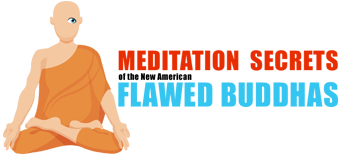Last Updated on September 25, 2020 by Paul Farrell, MRP, JD, PhD

The art of “doing nothing”… Yes, trust those absolutely essential pauses between one action meditation… and the next!
“Anytime you either slow down, resist a task, or invent some inane reason for getting behind schedule, pay special attention. Take these organizational lapses as an indication that you are on the verge of some major breakthrough.
You are probably entering a zone of creativity.
Don’t intervene with the process at hand.”
– Veronique Vienne, The Art of Imperfection
Everyone loves this way of meditating. Start by asking yourself: Where do our creative ideas come from? Are you the creator, the source, the master of your own fate? Or do creative ideas come to us from somewhere else while we are “sitting quietly, doing nothing,” as Eastern mystics suggest?
Are some mortals – Michelangelo, Thomas Edison, James Michener, Picasso and Alfred Hitchcock – born idea generators? How much depends on what we do with our creative talents, designing buildings and inventions, writing historical novels, creating works of art and film? Are we the creators or just vehicles for some universal Creator, the Mastermind as Napoleon Hill calls it, a power that works through us in mysterious ways?
In Success Through a Positive Mental Attitude Napoleon Hill relates a wonderful little story about an interview he had with Dr. Elmer Gates, a scientist who owns a couple hundred patents on his inventions.
“Seeing” New Ideas – Silent Action in the Dark
When Hill arrived, Gates’ secretary apologized and said he’d have to wait, perhaps a few hours – her boss was “sitting for ideas.” So Hill sat patiently and waited. When Gates finally emerged from his sound-proof meditation chamber, as we’d call it today, Gates “explained that when he was unable to obtain an answer to a problem, he went into the room, sat down, turned off the lights, and engaged in deep concentration. He applied the success principle of controlled attention, asking his subconscious mind to give him an answer.”
Hill wrote that in the late fifties, before the meditation practices of Zen Buddhism became popular in America. So while his Positive Mental Attitude language reflects the thinking of the Western business world, there is, nevertheless, a strange similarity between Gates’ scientific approach and the meditation practices of Eastern mystics expressed in the 13th century Zen poem: “Sitting quietly, doing nothing, spring comes and the grass grows.”
A Kick in the Pants, a Whack on the Head
And You’re Thinking Outside-the-Box
“There’s no right way to be creative,” says Roger von Oech in A Kick in the Seat of the Pants, “each creative thinker has his own style.” He should know, von Oech’s president of Creative Think, a leading consultant to Corporate America. But in spite of our differences, we can improve our odds of generating better creative solutions.
How? By using the kind of tools he discusses in Kick and his other classic, A Whack on the Side of the Head: How You Can Be More Creative. As von Oech puts it, when it comes to creativity, we’re our own biggest enemy: “When there is a need to ‘think something different,’ our own attitudes can get in the way. I call these attitudes mental locks.” Solution? If you can’t forget about them, whack yourself on the side of the head and “dislodge the presuppositions that hold the locks in place.”
In today’s high-tech world, ideas create wealth and power. Look at who’s on top of the Forbes 400 and the Fortune 500. Thinking “different” is also the key to individual wealth building says Thomas Stanley in The Millionaire Mind: “What do most millionaires tell me they learned?” he asks rhetorically. “They learned to: Think differently from the crowd.” As a result, his entire book was “designed around a central theme: It pays to be different.”
In Today’s Mega-Pressure 24/7 World
Stop Trying, Just Sit Quietly and Do Nothing
Every creative thinker in the business world has their own style, whether you’re an entrepreneur on Main Street, working inside Corporate America and a dealmaker on Wall Street. Some of us are born innovators, and yet all of us can sharpen our creative edge. Persistence helps: It did for Thomas Edison when he was inventing the light bulb. Others get it in a sudden inspirational flash. Still others, like Gates, came up with creative solutions while “sitting quietly, doing nothing,” meditating in his dark, quiet sanctuary.
And yet, while there may be no one right way to think creatively in today’s super-rational, high pressure, competitive business world, creativity often comes only when we stop trying so hard… even stop trying altogether… take a break and go to a movie… walk around the block… play Ping-Pong… go exercise at the gym… or think outside-the-box in bizarre, whimsical ways… be a child, play games with make-believe friends.
“For a child, doing nothing doesn’t mean being inactive, it means doing something that doesn’t have a name,” says Veronique Vienne in The Art of Doing Nothing. “You can recapture that moment of utter serenity simply by refusing to put a label on everything you do. Practice doing ‘nothing’… by uncluttering your mind.”
Less is More… Lots More… Of Living… Your Life!
Meditation is becoming increasingly popular because today’s business world is so out of balance. We have forgotten that, as with music, the quality of the creation is often measured by the silences between the notes.
Elmer Gates understood the need to balance active thinking with periods of “doing nothing,” he was like a Tibetan monk. Today’s business arena is so overwhelmed by a relentless rapid-fire barrage of loud notes that we have to go out of our way if we hope to program more silence in between the notes – that is, more time for the creative child within us to do nothing, as only a child can.
Trust the Signals
You Will Know When to “Do Nothing”
And you will know instinctively when it’s time to do nothing: “Anytime you either slow down, resist a task, or invent some inane reason for getting behind schedule, pay special attention,” says Vienne Veronique in The Art of Imperfection. Trust yourself:
“Take these organizational lapses as an indication that you are on the verge of some major breakthrough. You are probably entering a zone of creativity. Don’t intervene with the process at hand … Be just as patient with yourself … Heedless bustling is evidence that you are on a holding pattern, waiting for the next available landing strip in your brain. … According to productivity experts, taking frequent breaks yield higher profits.”
Listen closely and trust your creative insights. “You are at the center of a formidable information network,” says Vienne in The Art of the Moment:
“Moment by moment a sixth sense keeps you updated on your inner state, your thoughts, your feelings. You instantly know everything there is to know about yourself. Trust the signals, you will know when to bull ahead – and when it’s time to “sit quietly and do nothing.”
An Accidental Trip into Enlightenment
Where Fifty Bucks is Better than a Million
Creative insights, brainstorms, an epiphany, aha moments, enlightenment, call it whatever you want, many of us are searching for this elusive, intangible something. And whatever it is, we want more of it! Vienne described this amazing search in rather simple language:
“What is enlightenment?… Hundreds of Zen stories tell of how monks failed to attain satori after decades of practice, only to stumble on it by accident. The anecdotes are interpreted as evidence that you can only prepare for spiritual change, you cannot control it.
Reaching enlightenment is a bit like winning the lottery – not a million-dollar bonanza, mind you, just fifty bucks. The odds are in your favor. Years later, you’ll laugh remembering how sudden yet how anti-climatic the event really was. You’ll wonder why it wasn’t more emotional or dramatic.
You probably weren’t meditating. Chances are you were waiting for the light to change at an intersection, or looking out the window while talking on the phone, or washing dishes after a party. You were not prepared for it. No one can expect the unexpected – no one is every ready to be enlightened.
Your moment of enlightenment came packaged as a thought bubble. On a scale of one to ten, it was probably a number four insight….
Enlightenment is just another word for feeling comfortable with being a completely ordinary person. At long last, the unexceptional seems extraordinary enough: a puddle of water, a child running after a bird, the peaceful hum of your computer – and you, in the midst of it all, with your unvarnished self-image. The charade is over and a painful existential headache is gone. You are not a perfect human being – far from it – but your mind is clear. For the first time, you feel unflustered, alert, and ready to go.”
When Doing Nothing – Just Do Nothing!
And Let “Nothing” Do “Something” for You
When you get this, when you truly understand that doing nothing is the natural way to enlightenment in an everyday world loaded with problems, then it should be very easy for you to understand that doing anything can be a meditation! When it happens for you, just remember, there are few if any enlightened beings in the world, only enlightened moments.
So enjoy doing nothing, and stay open, so that “nothing” can do something for you.
About the Author
Dr. Farrell is a Behavioral Economist. His books include The Millionaire Code; The Millionaire Meditation: Stress Management for Wall Street, Corporate America & Entrepreneurs; The Zen Millionaire; The Winning Portfolio; Expert Investing on The Net; Mutual Funds on The Net; and The Lazy Person’s Guide to Investing.
He also published 1,643 columns on DowJones-MarketWatch and for years was their #1 traffic-generating columnist. Before the Internet, he edited & published FNX: Future News Index, a financial newsletter for stock market traders. Earlier he was a Wall Street investment banker with Morgan Stanley, Executive Vice President of the Financial News Network; and Associate Editor of the Los Angeles Herald Examiner.
He has a Doctorate in Psychology, Juris Doctor, Masters in Regional Planning and Bachelor of Architecture. He worked on the Esalen organic farm and served in the U.S. Marine Corps as Staff Sergeant in aviation computer technology.








